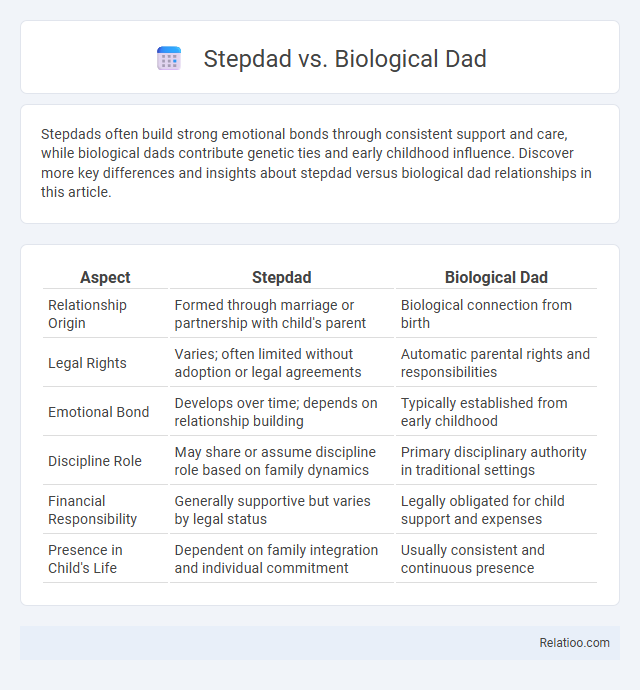Stepdads often build strong emotional bonds through consistent support and care, while biological dads contribute genetic ties and early childhood influence. Discover more key differences and insights about stepdad versus biological dad relationships in this article.
Table of Comparison
| Aspect | Stepdad | Biological Dad |
|---|---|---|
| Relationship Origin | Formed through marriage or partnership with child's parent | Biological connection from birth |
| Legal Rights | Varies; often limited without adoption or legal agreements | Automatic parental rights and responsibilities |
| Emotional Bond | Develops over time; depends on relationship building | Typically established from early childhood |
| Discipline Role | May share or assume discipline role based on family dynamics | Primary disciplinary authority in traditional settings |
| Financial Responsibility | Generally supportive but varies by legal status | Legally obligated for child support and expenses |
| Presence in Child's Life | Dependent on family integration and individual commitment | Usually consistent and continuous presence |
Understanding the Roles: Stepdad vs Biological Dad
Understanding the roles of a stepdad versus a biological dad involves recognizing that bonding, emotional support, and active involvement define fatherhood beyond genetics. Your relationship with a stepdad can be just as meaningful and influential, as consistent care and affection build trust and family unity. Social stigma often challenges stepdads, but prioritizing love and responsibility helps overcome misconceptions and strengthens family bonds.
Emotional Bonds and Attachment
Emotional bonds between stepdads and children often develop more gradually than those with biological dads due to differing attachment histories and social expectations. Biological dads typically benefit from early attachment formed through genetics and caregiving, while stepdads must navigate social stigma that can hinder trust and emotional closeness. Understanding these dynamics can help you foster stronger, healthier relationships by addressing biases and prioritizing consistent, empathetic interaction.
Legal Rights and Responsibilities
Stepdads often lack automatic legal rights and responsibilities compared to biological dads, who are recognized as the child's legal parent at birth with full parental rights. You may need to pursue legal adoption or guardianship to obtain parental rights as a stepdad, ensuring the ability to make decisions regarding your stepchild's welfare. Social stigma can complicate these legal processes, as assumptions about parental roles influence court decisions and public perceptions.
Challenges in Blended Families
Blended families often face unique challenges as stepdads navigate complex roles that differ from biological dads, including establishing authority and building emotional bonds without traditional biological ties. Social stigma can further complicate these relationships by imposing expectations or fostering judgment about step-parents, leading to tension and insecurity within the family dynamic. Effective communication and empathy are essential in overcoming these hurdles to create harmonious and supportive blended family environments.
Navigating Loyalty Conflicts
Navigating loyalty conflicts between stepdads and biological dads requires understanding the complex emotional dynamics and societal pressures involved. Children often experience conflicting feelings of allegiance, where social stigma can pressure them to favor biological ties, complicating their relationship with stepfathers. Effective communication and recognizing the unique roles both parental figures play help foster healthier family bonds and reduce loyalty conflicts.
The Impact on Child Development
Stepdads often face social stigma that can affect family dynamics and a child's emotional development, as children may struggle with loyalty conflicts or attachment issues related to their biological dad. Research highlights that positive involvement from stepdads can mitigate developmental challenges by providing stability, support, and alternative role models. The quality of relationships, rather than biological ties, significantly influences a child's social and psychological outcomes during crucial developmental stages.
Building Trust and Respect
Building trust and respect between children and their stepdads often requires deliberate effort and consistent positive interactions, as stepdads may face social stigma and preconceived notions about their role. Biological dads typically benefit from established bonds and societal expectations that support their authority, making trust-building more inherent but still requiring emotional presence and reliability. Overcoming social stigma involves open communication, patience, and demonstrating genuine care to foster meaningful relationships regardless of biological ties.
Effective Co-Parenting Strategies
Effective co-parenting strategies between stepdads and biological dads prioritize clear communication, mutual respect, and consistent parenting approaches to reduce social stigma and foster a supportive environment for children. Establishing defined roles and boundaries helps blend family dynamics while addressing concerns related to loyalty and identity often emphasized in social stigma. Collaborative decision-making and shared responsibilities enhance trust and stability, ultimately benefiting children's emotional well-being and family cohesion.
Societal Perceptions and Stereotypes
Stepdads often face societal skepticism and negative stereotypes compared to biological dads, being perceived as less invested or legitimate parental figures. Social stigma reinforces assumptions that step-parental relationships are inherently conflicted or less nurturing, despite research showing many stepdads provide strong emotional support and stability. These biased societal perceptions impact family dynamics and the recognition of stepdads' roles, perpetuating unequal treatment in social and legal contexts.
Supporting Healthy Family Dynamics
Stepdads and biological dads both play crucial roles in fostering supportive and healthy family dynamics by offering love, guidance, and stability. Understanding and addressing social stigma around non-biological parenthood helps promote acceptance and strengthens family bonds. Your active commitment to open communication and mutual respect can bridge gaps and create a nurturing environment for all family members.

Infographic: Stepdad vs Biological Dad
 relatioo.com
relatioo.com